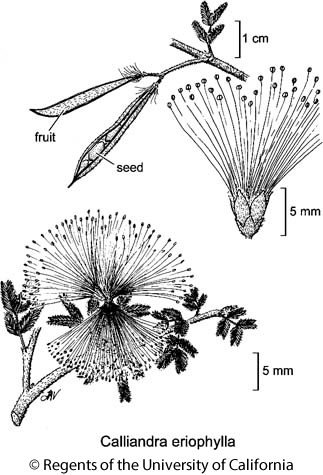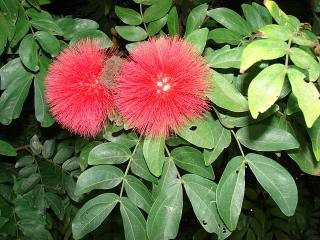Calliandra
Common Names: Calliandra
Scientific Name: Calliandra calothyrsus
Climate: Warm and temperate
Plant Description1: Evergreen or deciduous tree or shrub, rarely reaches a height greater than 10 m, with a diameter up to 20 cm. Dense crown. Feather-like leaves 18 to 25 cm long. It blooms in dense, narrow clusters, 15-20 cm long. The flowers are usually pink and/or white. Fruits are 7 to 11 cm long, dry-green, smooth or covered in small, brown hairs. Calliandra is a leguminous tree, and its seeds grow in pods like other legumes.
It is a native plant of the humid and sub-humid zones of Central America and Mexico. They flower all year round, but the best flowering time is in spring and summer.
Cultivation: It is a tree that has to be in full sun, which tolerates annual rainfall up to 4000 mm. It is not very tolerant to drought and the plant dries out under severe droughts. However, it usually recovers after the start of the rainy season.
It is adapted to different types of soil. The best growing conditions are lightly textured, slightly acidic soils, but it also adapts well to acidic soils with low fertility and is able to grow in infertile and compacted soils. It needs good drainage.
The seeds or seedlings are usually sown at the beginning of the rainy season. They can be sown directly into the ground - the area where they are sown must be fertilized and free of weeds. Sow the seeds at a depth of 1 to 3 cm with a spacing of 1 or 2m between plants. The seeds can germinate without treatment, but to accelerate germination soak them in cold water for 48 hours. They can be sown in tall seedbeds or containers until they reach a height of 20 to 50cm, with a root collar diameter of .5 to 1 cm. Once they reach that size they can be transplanted - after 4-6 months of age.
Another method of reproduction is to produce stumps; in this case, the seedlings can grow for 4 months until they reach a height of 75 to 100 cm and can then be transplanted. Breeding with stumps is very useful for interspersing between other trees or for better establishment on steep slopes. Sowing or transplanting to the final location is done at the beginning of the rainy season.
At first it grows slowly, but later the plant grows rapidly to 3.5 m in 6 months. Thus it is necessary to keep the soil free of weeds in the first year, but after that the weeds no longer cause any problems. After one year the plants can reach 3-5 m high and 5 cm in diameter at the stump. This is a good size for firewood use. Harvest at the end of the dry season. To get it growing again quickly, make the cuts 20 to 50 cm above the ground.
Seeds are produced during the dry season. The seeds can be harvested, dried and stored for one or two years.
The first cut can be made 8 to 12 months after sowing. For maximum leaf production, cut at a height of .5 to 1 m. every 2 or 3 months.
To avoid leaf loss in the dry season, do a pruning at the end of the wet season. It has the ability to cope with repeated cutting. It stands out for its ability to withstand regular defoliation and its rapid growth.
 Uses: It can be used for reforestation in tropical areas. It prevents soil erosion; its deep root system and numerous lateral roots give the soil better structure. It attracts pollinators such as bees. Serves to provide shade for coffee plants. The wood dries very quickly and is an excellent firewood for cooking as it burns well. It is a plant that is used for livestock feed, although it is not of very good quality. It is a leguminous plant and thus improves soil quality and fertility by adding nitrogen.
Uses: It can be used for reforestation in tropical areas. It prevents soil erosion; its deep root system and numerous lateral roots give the soil better structure. It attracts pollinators such as bees. Serves to provide shade for coffee plants. The wood dries very quickly and is an excellent firewood for cooking as it burns well. It is a plant that is used for livestock feed, although it is not of very good quality. It is a leguminous plant and thus improves soil quality and fertility by adding nitrogen.
Pests and Diseases: Pests only cause minor damage. Young plants can be attacked by the teak shoot borer. Fungal attacks can cause serious damage when plants are cut too low before a rain or during the wet season.
Referencias:
En español: Calliandra

